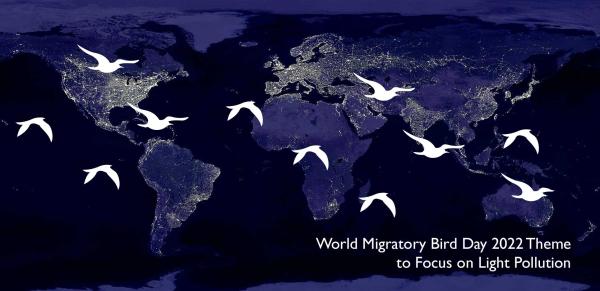
The Executive Secretary, Convention on the Conservation of Migratory Species of Wild Animals (CMS), Amy Fraenkel, has explained that natural darkness has therapeutic tendencies for the ecosystem against the excessive introduction of artificial light across the globe. The goal of the statement was to emphasize the need to discourage light pollution, as it affects the lives of birds and other animals. The statement has been highlighted by the United Nations for the celebration of this year’s World Migratory Bird Day (WMBD).
It is believed that every living thing move from one place to another in search of more comfortable living condition, ranging from food, shelter, mate, better climatic condition, among others. Birds are not, in any way, excepted. It is estimated that about 118 million birds can leave a location in a single night in spring (30 March–1 April) and 148 million in autumn (17–18 October), which were the peak of migration (according to a study conducted by Raphaël Nussbaumer and others, published on the Journal of the Royal Society Interface in 2021).
It is widely reported that about 4,000 different bird species travel long distances, making up about 40% of the world’s bird population. They migrate in search of food. Twice a year, these birds spend the winter in warmer regions before coming home to reproduce.
Nevertheless, there are many different migration patterns. The majority of birds migrate from northern breeding areas in the summer, to southern wintering grounds. However, some birds breed in southern parts of Africa and migrate to northern wintering grounds, or horizontally, to enjoy the milder coastal climates in winter. Other birds migrate in terms of altitude, moving higher up a mountain in summer, and residing on lowlands during the winter months.
Meanwhile, Avian migration is a natural process, whereby different birds fly over distances of hundreds and thousands of kilometres in order to find the best ecological conditions and habitats for feeding, breeding and raising their young. When the conditions at breeding sites become unfavourable due to low temperatures, migratory birds fly to regions where conditions are better.
It was on this note that the need for celebrating migration bird arose. The day was established as a result of the United Nations’ Agreement on the Conservation of African-Eurasian Migratory Waterbirds. The concept of World Migratory Bird Day was born in the US in 1993, when a number of organisations and agencies began commemorating the day. The United Nations (UN) chose to promote awareness of migratory birds’ linkages to various geographic areas around the world in 2006. Since then, 118 nations have engaged in and attended the event. It is usually celebrated twice in a year, second Saturday in May and second Saturday in October.
Just as humans and other living things that migrate to a distant location at a particular point, migratory birds face several challenges. This is because migration is stressful. Thus, the only goal of World Migratory Bird Day is to protect the ecosystems used by migratory birds for breeding, non-breeding, and stopover while maintaining a healthy bird population.
The event has always been revolving around the objective of making the environment safe for the birds, as they migrate. This year’s theme is “Dim the Lights for Birds at Night”. The theme, as explained by the United Nations, is aimed raising alarm on the consequences of light pollution to birds. According to the UN, "As migratory birds journey across borders, inspiring and connecting people along the way, it is our aim to use the two days in 2022 to raise awareness of the threat of light pollution and the importance of dark skies to bird migrations.” Birds are seen as environment-friendly creatures.
The CMS has outlined steps to ensure safer nights for the birds as explained by its executive secretary, Ms Fraenkel. According to her, many cities are complying by taking measures to dim building lights during migration phases in spring and autumn. It is estimated that artificial light level is on the increase, with about 2.2 per cent per year from 2012 to 2016, according to a study cited by the Secretariat of the Convention on Migratory Species of Wild Animals (CMS), a UN environmental treaty. The UN added that “currently, more than 80 per cent of the world's population is estimated to live under a ‘lit sky’, and the figure is closer to 99 per cent in Europe and North America.”
On his own part, the Executive Secretary, Agreement on the Conservation of African-Eurasian Migratory Waterbirds (AEWA), Jacques Trouvilliez, explained that while fighting climate change, efforts should be made to reduce artificial light that gives rise to light pollution. “As we have to reduce our fossil fuel consumption to fight against climate change, saving energy in many countries will imply reducing lights not only along streets but also in many buildings. This will undoubtedly reduce light pollution and benefit migratory birds. Climate change and biodiversity conservation are again closely linked and it is important to highlight the many positive effects that saving energy will bring,” he declared.
Many events have been lined up for marking this year’s edition of the World Migratory Bird Day across the globe, throughout the month of October. These include bird festivals, education programmes, media events, bird watching trips, presentations, film screenings and a benefit concert to raise funds for international nature conservation. They are all geared towards creating awareness on the need for making the earth safer for birds. The latest is a virtual event scheduled for 27th October, in America. Participants will have the opportunity to meet Paul Bogard, author of The End of Night.






















